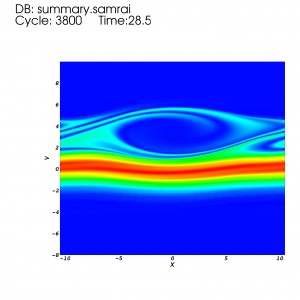A passion for pressure

A visualization of a Vlasov-Poisson simulation for a bump-on-tail instability problem, where a non-equilibrium distribution of electrons drives an electrostatic wave. The image shows particle density as a function of space and velocity. (Jeffrey Hittinger, Lawrence Livermore National Laboratory.)
Lawrence Livermore National Laboratory (LLNL) computational scientist Jeffrey Hittinger spends his life at extremes. On the job, he focuses on the physics of plasmas – searing clouds of speedy ions and electrons – for fusion energy. Outside work, he tends goal for a San Francisco Bay-area amateur hockey team. Instead of simulating flying particles, he’s blocking or catching flying pucks.
His two interests share a fast pace – extraordinarily fast for plasmas – and a challenging nature. “I’m attracted to difficult things,” Hittinger says, then laughs. “I’m a goalie, so maybe I’m interested in difficult, high-pressure things.”
Likewise, “we get to work on hard problems” at the lab’s Center for Advanced Scientific Computing (CASC), Hittinger says. And like pucks flying in from unexpected directions, “there are always new problems coming at you.”
Hittinger, a Department of Energy Computational Science Graduate Fellowship (DOE CSGF) recipient from 1996 to 2000, creates and tweaks computer algorithms that emulate and elucidate aspects of some of the world’s most complex experiments.
“It’s a mixture of my background and what I stumbled into when I came to the lab,” Hittinger says. As a graduate student, he used gas kinetics to model fluid mechanics. Lab personnel recruited him to improve fluid plasma models for laser-driven inertial confinement fusion (ICF), the goal of the National Ignition Facility (NIF).
In NIF’s stadium-sized building, powerful lasers shoot into a hohlraum, a thimble-sized container holding a BB-sized capsule of frozen hydrogen isotopes. The laser pulse generates powerful X-rays, imploding the pellet with tremendous pressure and heat. The hydrogen atoms fuse, releasing energy in a process similar to that powering the sun.
“For ICF to work, you have to get a nice, clean implosion,” Hittinger says. “To do that, you need all the energy you’re putting into the system to go where you want it to go.” Plasma, however, can interact with the lasers, scattering or reflecting them.




